Spotlight: Hal Bromm Gallery
Because this site focuses on news, the businesses that have been around awhile—and that make this neighborhood special—don’t get the coverage they should. The Spotlight series is a feature for the OGs.
Hal Bromm opened his eponymous gallery here in 1976 — the first strand of DNA for what is now a bonafide Tribeca Gallery District. He started at 10 Beach in 1975, moved to Franklin in ’76 and then settled at 90 West Broadway in 1977, where he’s been ever since. On view now: a solo show of Lucio Pozzi titled “Time and Again: 1974 / 2018 / 2021.” He also served on CB1 for 12 years, was president of the Historic Districts Council and created the Knowlton Township Historic Commission in New Jersey.
What brought you to Tribeca?
I had friends in Soho and I looked around there but this neighborhood appealed to me because it wasn’t really a neighborhood. I loved that it was kind of a no-mans land. A friend had taken a floor in a cheese warehouse [10 Beach] – $250 a month for the fourth floor. I took a floor there and stayed almost five years. At one point early on, the building owner told us he had terminal cancer and had to sell the building and asked if we all wanted to buy it. To me it was a no brainer but everyone else was freaked out because they were used to being a tenant. So I bought the building myself by borrowing money from anyone I knew. Eventually I co-oped the building and everyone bought their floor for $20-25,000.
How did you get started in this business?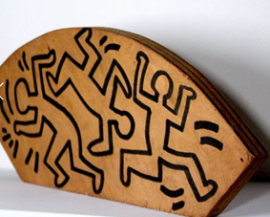
I was working for an architectural firm and doing all the interiors for the board members and executives of Exxon (which was then Standard Oil of New Jersey) as they moved into a new office tower that they had built. In 1973 I left the architectural firm and started my own design firm at 10 Beach, specializing in space planning, interior design and art consultation. I got an offer to run a civil design firm in London for two years and when I came back here in ’75, I brought work by a group of young British artists who I knew through David Hockney, who I met through Henry Geldzahler, who was a curator at the Met. He was a regular at the Odeon in the early days. A great character.
When I was coming back to New York, I said to that whole group, why don’t you give me a piece of work and I’ll make a show in my loft? They did and I did. It was called New London in New York. And that was the first show I put together. Friends who saw that said you should have a gallery. And one guy said there’s a great space on Franklin, you should rent it. And I did.
The only downside was it was the top floor of a five-story walkup. The deal was the elevator operator would bring people up if he happened to be there. One day a noted art critic came to see the show and the elevator didn’t come so he walked up five flights of stairs. And there he was, breathless, and I said we gotta get out of here. I started scouting the neighborhood and this building [90 West Broadway] had a for-rent sign for the top floor. Here the views were better and there were two automatic elevators.
Why here?
I never thought about going elsewhere ’til the ’80s, when the East Village was sort of catching fire and there were a lot of exciting artists showing there. I decided to open a gallery space there as an adjunct to this one, but I never gave up on being in Tribeca. When we opened there was a space called Franklin Furnace run by Martha Wilson, which was a non-profit and artist-booked. Eventually a bunch of other galleries came — Art In General, Soho Photo, PPOW. But I was the first commercial gallery in Tribeca.
What are you known for?
I would say we are known for cutting edge new work – showing people what was about to happen. That’s what we did in the East Village. In the ’70s we were showing minimal work. Now we’ve got someone like Joey Tepedimo, a self-taught artist. We are always looking at new art. [In the 1980’s, Bromm gave shows to several up and coming East Village artists, including David Wojnarowicz, Russell Sharon, Luis Frangella and Judy Glantzman.]
In 1981 I did a show of Keith Haring – it was the first commercial gallery show that he had done. The work was pretty magnetic. I had seen his work in the subway – he did drawings on the subway advert panels. When the ad time had expired, they would put black paper over the panel and Keith would come along with a piece of white chalk and do drawings then jump off the train and jump on the next car and do more drawings. Nobody knew where these drawings were coming from. He also liked to do drawings on found objects — he would find things on the street, paint them and draw on them.
For our 30th anniversary show, we featured four guys, all of whom had died from AIDS early in their careers.
What’s the most satisfying part of what you do?
The people. The artists and collectors and the people I get to work with. But also the art, of course. You don’t get into this business if you don’t love art. In 1974, I talked to Paula Cooper. And she said, “Hal, don’t expect to make any money.” But eventually I made money.
The art world today is so different. Art has become a commodity – it’s an investment, a status marker. But for a lot of young people, at the lower end of market, they can buy things that are better than hanging a poster.
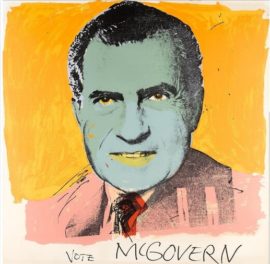 Is there one that got away?
Is there one that got away?
When McGovern ran for president [in 1972] for $500 you could buy a Warhol print with the face of Richard Nixon and underneath Warhol hand wrote Vote McGovern. So I scraped together $500 and bought one. I wish I still had it.
You always regret what you didn’t do and not what you did do. There was a client who came in with a beautiful Rothko and asked me to sell it and I said sure. I wish I kept it. There was a little de Kooning. There was a Cy Twombly. How big is my collection? Too big.
Tell me a good customer story.
Edward Albee was one of my favorite customers. I met him through friends – we were all neighbors. He was just great. He was kind of irreverent and very direct. One of the first things he said is, “I usually don’t like art dealers.” He preferred to work directly with the artists if he could. He collected anything and everything – his tastes were really broad. But it all worked.
[In 1984, Bromm formed “The Committee for the Washington Market Historic District” whose goal was to preserve the buildings and squares that formed the old Washington Market, eventually lobbying the NYC Landmarks Preservation Commission to designate the area a historic district. The Tribeca West Historic District was adopted in 1991, followed in 1993 by Tribeca North, South and East.]
One year many years later I asked if he would help with a fundraiser for the Historic Districts Council. We were thinking of doing a theater night and I asked if he would come to a little cocktail party. He said he hated cocktail parties but he came anyway. He also signed the Dear Neighbor letter to protect the area. He and Bob De Niro and Jim Rosenquist all agreed to sign it. The press loved the fact that all these people had signed the letter.
Where do you eat/drink around here?
When people come from out of town I always gravitate to Lynn at the Odeon. I’ve taken people to Racine’s. Marc Forgione has done a good job. I like his cooking. I miss the women who had Kitchenette. Frenchette Bakery is a favorite. And Batard is very good.
What does the future hold?
I wonder. I’ve been talking to other dealers about their legacy plans and a lot of people don’t have one. I’ll do this as long as I can. If you love it, you will keep wanting to do it.
What didn’t I ask?
What’s my favorite color? All of them. That’s probably enough.
Coda
As noted above, Bromm is also a preservationist, and his first foray into protecting the neighborhood was at the intersection of Hudson, West Broadway and Chambers — what we now know as Bogardus Plaza.
When I moved here in ’77, the Frederick Hotel was an SRO (single room occupancy) and Bogardus Triangle had five trees and tree pits filled with broken bottles. I said, “This is our neighborhood. We have to be in charge of it a little bit.” So we planted bulbs and we got the bum guys who hung out there to stop throwing bottles and be stakeholders and amazingly it kind of worked. Years later Carol De Saram got a grant to turn the traffic triangle into a garden and that was the birth of the Bogardus viewing garden. At some point I inveigled Tory Weil to join our little group and she made it what it is today.
And a little post script:
The painting in the lobby has a fun origin story that I will tell another time, but in the meantime, the piece, “Dreamer” by Luis Frangella, is on loan to MOMA PS1 for the fifth edition of the show “Greater New York,” which opens Oct. 7.







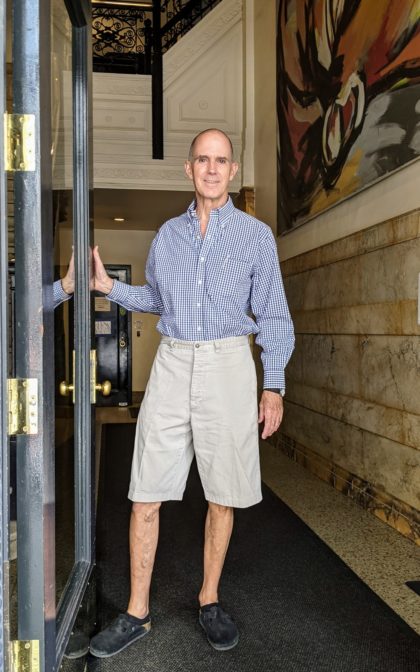
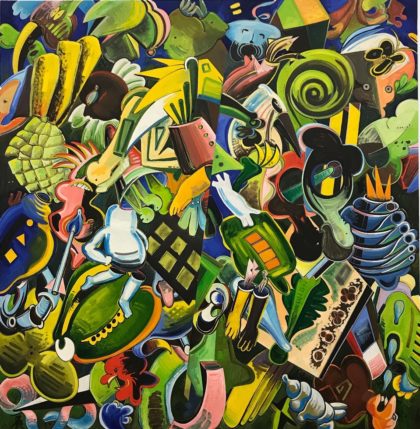
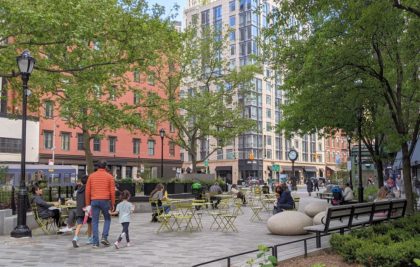






Great story about a truly special Tribecan.
Through this article, Hal Bromm’s loving attention to his surroundings certainly comes through. He is an innovator and driven by a care for the common good, his perseverance has set an example of what a community can achieve : appreciation and respect for the neighborhood and its people. His taste and his openness reflect the love he has for the arts and also for people.
Hal has a wonderful non-sentimental relationship to the past and at the same time a firm foot in the present. I am happy and proud to consider him a friend.
Björn
Geneva/Switzerland
Wonderful article about an amazingly effective and inspirational leader in historic preservation, the arts and good citizenship. Hal’s championing of new and young artists has changed lives, both the lives of some of the artists as well as of the collectors he introduced to their work. The interview is excellent.
Hal has always led by example. I was fortunate enough to have met Hal in Key West, FL where he spearheaded some art projects there, tastefully and successfully. True testimony, by the interview, that Tribeca has also felt his presence. Hal Bromm, a true leader and role model.
Hal has always led by example. I was fortunate enough to have met Hal in Key West, FL where he spear head some art projects there, done tastefully -and successfully. By the interview, it’s true testimony that Tribeca has felt his presence. Hal Bromm, a true leader and role model.